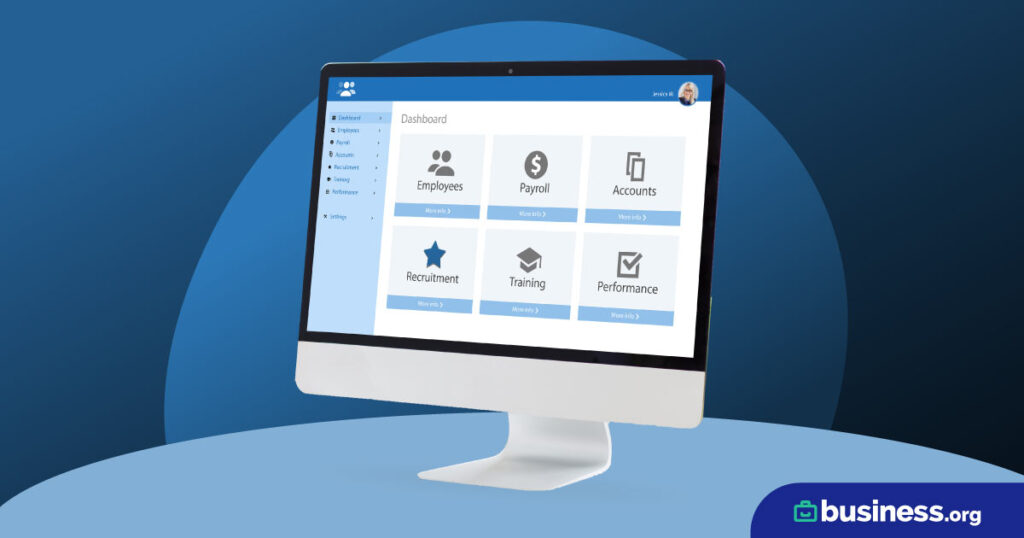We are committed to sharing unbiased reviews. Some of the links on our site are from our partners who compensate us. Read our editorial guidelines and advertising disclosure.
Types of Payroll Systems
Isn’t it beautiful when the universe hands you the right number of options—not enough to overwhelm you, but not so few that you feel trapped?
Well, guess what? There are only three main ways small businesses take care of payroll, so you don't have to sift through a million methods before finding the right one. That is truly a gift from the universe, especially when working your way through tax codes.
Before you choose the right option, though, you have to know how each one works. In this article, we overview the three main types of payroll—by hand, software, and outsourcing—so you can see how they’re done.
Types of payroll systems table of contents
Option 1: Do-it-yourself payroll
Recommended for small businesses with low financial complexity and only a few employees.
Let’s start with the cheapest option: DIY payroll. If you want to do payroll yourself, with no software or external help, the process will start out like this:
- Collect employees’ W-4 forms.
- Set a pay schedule (weekly, bi-weekly, and monthly are most common).
- If you have hourly employees, collect their hours worked.
- Calculate employees’ gross pay by multiplying hours worked by wage.
- Deduct federal and state income taxes.
- Deduct Social Security and Medicare taxes (also called FICA taxes).
- Deduct other withholdings (wage garnishments, 401k contributions, health care premiums, etc.).
- Pay employees their net pay.
Notice that we said, “start out”? These eight steps are just the easiest, most basic part of doing payroll yourself. But there are other key items of business, including the following:
- Applying for an Employer Identification Number (EIN) so you can officially collect and file taxes
- Sending payroll taxes and tax forms to the federal government on a regular schedule
- Creating a thorough tax schedule so you don’t miss tax deadlines throughout the year, not just in April
- Updating employees’ W-4 forms and tax withholdings when they experience major life events like marriage
- Adjusting time and pay for overtime, vacation days, and sick days
- Calculating and submitting FUTA taxes (Federal Unemployment Tax Act taxes) based on your employees’ salaries
- Entering all payroll information in your payroll journal, payroll register, and general ledger
- Distributing pay and pay stubs by setting up a payroll direct deposit system, writing and mailing checks, or using payroll cards
- Complying with local, state, and federal laws about taxes and payroll
- Sending W-2s and other tax forms to employees at the end of the year, and then submitting records of all W-2s to the federal government
A payroll journal is where you record all expenses related to the payroll process and how those expenses impact your overall finances. This means recording your employees gross salary plus expenses like FUTA taxes, FICA taxes, payroll financing, and payments you still owe employees (a.k.a. payroll accrual entries).
A payroll register is where you record each employee’s gross pay, net pay, tax withholding, and other deductions every pay period. The register should also include a gross tally of how much you paid your employees every pay period.
Reading through this far-from-thorough list makes it easy to see why we listed DIY payroll as the cheapest option, not the easiest. It isn’t for the faint of heart—more accurately, the faint of math skills and tax-code knowledge. Note that the way you do payroll differs slightly between hourly and salaried employees; if you have both types of employees, it’s essential that you keep their records straight.
And DIY payroll is not for small businesses with more than a handful of employees, unless you want to dedicate far more than your fair share of daylight hours to tallying numbers for dozens of people every pay period. (Doing the math for Social Security, Medicare, state, and federal income tax to calculate the right payroll deductions from every employee gets old fast.)
Still, calculating your employees’ take-home pay by hand—or with little more than an online payroll calculator and Excel spreadsheet—is doable, if daunting. So if you didn’t panic reading through the lists above and picturing what you’d do in a potential tax audit and you have only three or so employees, by-hand payroll could be a solid, affordable option for your business.
Interested in a more detailed breakdown of by-hand payroll? Hop over to our post, “How to Do Payroll Yourself.”
By signing up I agree to the Terms of Use.
Option 2: Payroll software
Recommended for small-business owners who don’t want to spend much time or money on payroll.
Doing your own payroll is great for saving money, but if you follow the adage that time is also money, DIY payroll puts you squarely in the red.
Of course, this isn’t a perfect world, which means all payroll options require time, money, and energy. Still, payroll software can save you so much more time that it isn’t comparable to DIY payroll.
But let’s give it the old college try—compare this five-step list of how to do payroll with software to our eight-step list of how to do payroll by hand:
- Find and purchase payroll software.
- Enter your business and employee information.
- Have hourly employees record and submit their time cards.
- Use the software to calculate payroll and keep records.
- Distribute paychecks.
Even with software, you’ll have to take some of the same extra steps you would with by-hand payroll, like requesting an Employer Identification Number (EIN). But you don’t have to create your own payroll journal or stress over accurate pay stubs. You can use a calculator or formula to make sure you’re deducting the right payroll taxes, or go out of your way to research this year’s tax rate, which . . . is kind of incredible.
A payslip, or pay stub, is a record that explains an employee’s paycheck: it shows the gross pay, deductions, withholdings, and net pay so the employee can see how much was deducted and why.
You aren’t required to give your employees payslips with every paycheck on the federal level. Instead, the Fair Labor and Standards Act (FLSA) says that employers must record only their employees’ wages and hours worked.
However, some states require employers to provide either a written or an electronic pay stub. Most other states require employers to make pay stub information readily available so employees can access it anytime. Only a handful of states lack rules about payslips.
But remember our introduction, where we talked about the pros of having the right number of options? Alas, this is where payroll software loses points.
There are hundreds of options for payroll software—some tailor-made for freelancers, some for businesses with under five employees, some for solo ventures, some for subcontractors . . . and all of them with their pros and cons to sort through.
That makes the first step, finding and purchasing the right payroll software for your business, the most time-consuming part of the process. Then you have to learn how to use it.
If you don’t know where to start, we have a few favorites you can sort through. But before you go on the hunt, ask these key questions to trim up your options:
- How many employees do you have?
- How much do you want to spend?
- How much tax support do you want?
- How worried are you about legal compliance?
- How much customer support do you need?
- How much time can you spend getting used to the software?
- How many features do you need? Do you need just payroll, or do you need payroll, invoicing, billing, and more?
- Do you want payroll software that integrates with other management systems, like HR?
- Do you want a free trial?
There’s enough payroll software out there that one option, at least, should fit most of your checked boxes.
Option 3: Outsourced payroll services
Recommended for mid-sized to large businesses with hefty financial needs.
Payroll software is a beautiful happy medium for employers who don’t want to dedicate loads of time and energy to payroll but do want to keep their own set of eyes on the numbers. But if your eyes aren’t great with numbers and figures, or if you honestly don’t have any time to spare on payroll, outsourced payroll is the choice for you.
Just like your small business specializes in what you’re passionate about, whether baking or hair cutting or gardening, outsourced payroll companies are passionate about payroll. And as odd as that might seem to the non-payroll-passionate among us, it’s downright marvelous when you consider how little it takes to do payroll when you outsource to another company:
- Find an outside payroll company you trust with your financial data.
- Pay your payroll company for their services.
- Communicate regularly with your payroll services to ensure you’re on the same page, especially about payroll taxes.
That’s about it, folks.
The minimal effort, of course, means a trade-off in cost. That’s why an outsourced payroll company makes the most sense for larger companies that prefer paying more to avoid the hassles of in-house payroll, such as making tax payments and creating payroll reports themselves.
And like every option, outsourced payroll has some downsides. It requires you to share your employees’ confidential data with an outside source, which is a little scary (and the primary reason to find a payroll company you absolutely trust). Another company might not have your business’s same computer security policies, software, or hardware, which adds another layer of potential info leaks for you to worry about.
But when tax time rolls around, there’s nothing better than a trustworthy payroll-specific company to make the season a breeze—and don’t forget that when you run a small business, “tax time” is all the time.
If you want to dedicate more time to your day-to-day operations instead of calculating payroll, deducting taxes, and making sure you’ve filed on time, an outsourced payroll company complete with payroll tax service might make the most sense for you.
Honorable mention: In-house accountant
What if your company’s too small for an entire outsourced team, but you don’t have any time to spend on payroll, or even on running software?
An in-house accountant has the same perks as outsourced payroll plus the perks of payroll software. You don’t have to worry much about payroll once you turn your financial info over to the accountant, but because your accountant works in your office, you still maintain some control over your data and pay distribution.
Here’s the thing, though: not all accountants are created equal. As with software and outsourcing, you’ll need to do some deep digging to find an accountant you can trust who also charges a reasonable price and can be counted on to have your back in an audit.
Plus, if you’re paying a part-time accountant by the hour, do you really want them to spend several hours a week entering wage information and recording payroll liabilities in your journal and ledger?
It might still make more business sense to deal with record-keeping and pay stub distribution yourself—which cuts down on the time-saving perk of hiring another person to deal with payroll and taxes in the first place.
The takeaway
In the wide world of payroll, there’s no one-size-fits-all solution . . . but there is sure to be one type of payroll solution out there for you, whether it’s doing payroll yourself, relying on affordable software, or trusting an outsourced payroll company to handle the hard stuff.
Additionally, as your business grows, your payroll needs will change—and that’s okay. Once you outgrow one solution, payroll provider, or piece of software, there’s another handy payroll tool ready to take its place.
Want a more in-depth look at how payroll works? See our post on payroll definitions and best practices to get started.
Related reading
Disclaimer
At Business.org, our research is meant to offer general product and service recommendations. We don't guarantee that our suggestions will work best for each individual or business, so consider your unique needs when choosing products and services.
Sources
1. National Small Business Association, “NSBA 2017 Small Business Taxation Survey” Accessed June 6, 2022.




